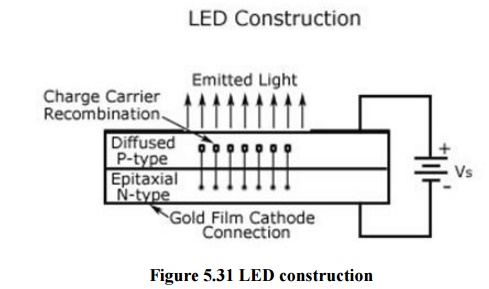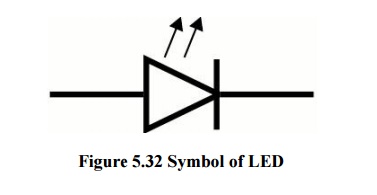Chapter: Electronic Devices : Power Devices and Display Devices
Light Emitting Diode (LED)
LIGHT EMITTING DIODE (LED)
A light emitting diode (LED) is known to be one of
the best optoelectronic devices out of the lot. The device is capable of
emitting a fairly narrow bandwidth of visible or invisible light when its
internal diode junction attains a forward electric current or voltage.
The visible lights that an LED emits are usually
orange, red, yellow, or green. The invisible light includes the infrared light.
The biggest advantage of this device is its high power to light conversion
efficiency. That is, the efficiency is almost 50 times greater than a simple
tungsten lamp.
The response time of the LED is also known to be
very fast in the range of 0.1 microseconds when compared with 100 milliseconds
for a tungsten lamp. Due to these advantages, the device wide applications as
visual indicators and as dancing light displays.
We know that a P-N junction can connect the
absorbed light energy into its proportional electric current. The same process
is reversed here. That is, the P-N junction emits light when energy is applied
on it. This phenomenon is generally called electro luminance, which can be
defined as the emission of light from a semi-conductor under the influence of
an electric field.
The charge carriers recombine in a forward P-N
junction as the electrons cross from the N-region and recombine with the holes
existing in the P-region. Free electrons are in the conduction band of energy
levels, while holes are in the valence energy band.
Thus the energy level of the holes will be lesser
than the energy levels of the electrons. Some part of the energy must be
dissipated in order to recombine the electrons and the holes. This energy is
emitted in the form of heat and light.
The electrons
dissipate energy in the form of heat for silicon and germanium diodes. But in
Galium- Arsenide-phosphorous (GaAsP) and Galium-phosphorous (GaP)
semiconductors, the electrons dissipate energy by emitting photons. If the
semiconductor is translucent, the junction becomes the source of light as it is
emitted, thus becoming a light emitting diode (LED). But when the junction is
reverse biased no light will be produced by the LED, and, on the contrary the
device may also get damaged.
The
constructional diagram of a LED is shown below.

Figure 5.31 LED construction
All the
semiconductorss listed above can be used. An N-type epit axial layer is grown
upon a substrate, and the P-region is produced by diffusion. The P-regi on that
includes the recombination of charge carriers is shown is the top. Thus the
P-region becomes the device surface. In order to allow more surface area for
the light to be emitted the metal anode connections are made at the outer edges
of the P-layer.
For the
light to be refle cted as much as possible towards the surface of the device, a
gold film is applied to the surface bottom. This setting also enables to
provide a cathode connection. The re-absorption problem is fixed by including
domed lenses for the device. All the wires in the electronic circuits of the
device is protected by encasing the device.
The light
emitted by t he device depends on the type of semiconductor material used.
Infrared light is produced by u sing Gallium Arsenide (GaAs) as semicond uctor.
Red or yellow light is produced by using Ga llium-Arsenide-Phosphorus (GaAsP)
as se miconductor. Red or green light is produced by using Gallium-Phosphorus
(GaP) as semiconduct or.
LED Circuit Symbol
The
circuit symbol of LED connsists of two arrow marks which indicate the radiation
emitted by the diode.

Figure 5.32 Symbol of LED
LED Characteristics

Figure 5.33 LED characteristics curve
The
forward bias Voltage-Current (V-I) curve and the output characteristics curve
is shown in the figure above. The V-I curve is practically applicable in
burglar alarms. Forward bias of approximately 1 volt is needed to give
significant forward current. The second figure is used to represent a radiant
power-forward current curve. The output power produced is very small and thus
the efficiency in electrical-to-radiant energy conversion is very less.
The
figure 5.34 shows a series resistor Rseries connected to the LED. Once the
forward bias of the device exceeds, the current will increase at a greater rate
in accordance to a small increase in voltage. This shows that the forward
resistance of the device is very low. This shows the importance of using an
external series current limiting resistor. Series resistance is determined by
the following equation.

Figure 5.34 LED circuits
The
commercially used LED’s have a typical voltage drop between 1.5 Volt to 2.5
Volt or current between 10 to 50 milliamperes. The exact voltage drop depends
on the LED current, colour, tolerance, and so on.
LED as an Indicator
The
circuit shown below is one of the main applications of LED. The circuit is
designed by wiring it in inverse parallel with a normal diode, to prevent the
device from being reverse biased. The value of the series resistance should be
half, relative to that o f a DC circuit.

Figure 5.35 LED as an indicator
LEDS displays are made to display numbers from
segments. One such design is the seven-segment display as shown below. Any
desired numerals from 0-9 can be displayed by passing current through the
correct segments. To connect such segment a common anode or common cathode
cathode configuration can be used. Both the connections are shown below.
The LED’s
are switched ON and OFF by using transistors.
Advantages of LED’s
§ Very low
voltage and current are enough to drive the LED.
§ Voltage
range – 1 to 2 volts.
§ Current –
5 to 20 milliamperes.
§ Total
power output will be less than 150 milliwatts.
§ The
response time is very less – only about 10 nanoseconds.
§ The
device does not need any heating and warm up time.
§ Miniature
in size and hence light weight.
§ Have a
rugged construction and hence can withstand shock and vibrations.
§ An LED
has a life span of more than 20 years.
Disadvantages of LED
§ A slight
excess in voltage or current can damage the device.
§ The
device is known to have a much wider bandwidth compared to the laser.
§ The
temperature depends on the radiant output power and wavelength.
Related Topics